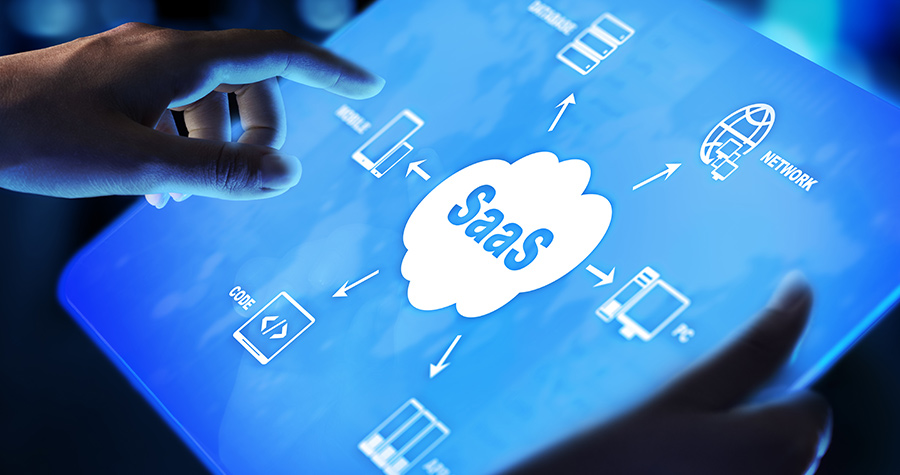
"SaaS" is shorthand for Software-as-a-Service, a term used to describe software that is web-based. SaaS software is installed on the vendor's server, not locally on your computer. To access the software, users connect to the vendor's site via the web.
For users, SaaS offers a number of key benefits.
-
Initial costs are normally much less than purchasing multiple copies of software or licenses to enable all employees to use the product.
-
SaaS normally is classified as an operating expense rather than a capital expenditure.
-
SaaS vendors typically release new or upgraded versions every few months, whereas traditional software providers often take one to two years to release a new version.
-
Finding outsource providers to integrate SaaS with legacy systems usually poses little challenge as most outsource vendors have multiple staff members who are well-experienced with the major SaaS vendors.
-
Most SaaS vendors offer online access to user manuals and training, so employees do not have to report to a session off-site.
-
Users can use SaaS applications as long as they have internet access.
-
SaaS is scalable, allowing users to start small and expand as their business grows.
-
Most SaaS service providers offer APIs that can facilitate integration, delaPlex has extensive experience in this area.
-
SaaS products such as those offered by Amazon, Salesforce and others allow the development and integration of customized solutions
-
The return on investment (ROI) is much lower for SaaS solutions versus on-premises software solutions. SaaS licensing and implementation costs significantly cheaper, upgrades are provided by the SaaS vendor at no additional cost and infrastructure costs are also cheaper with SaaS. Furthermore, SaaS does not require the high-end servers and desktops that many companies must purchase to run traditional software or upgrade to run the latest version.
Obviously, SaaS companies could not stay afloat long unless they were also receiving significant benefits as well. Many of these benefits are linked to the recurring revenue model that SaaS vendors can use.
-
The recurring revenue model lowers the bar for the company's IPO and can help attract venture capital funding. Analyzing and predicting "lump sum" sales can be more difficult than examining revenue from subscriptions, which can be likened to an annuity.
-
Companies operating under the recurring revenue model have opportunities to interact with their customers more frequently. This helps to minimize churn and also provides an opportunity to build a loyal customer base.
-
The recurring revenue model allows companies to capture consumer trends, customer preferences, and other data sets on a more granular level. Granting companies the ability target campaigns more precisely as well as fine-tune their services.
-
The recurring revenue model makes it easier to enter into collaborative or shared revenue agreements with partners. n 2012, Comcast and Microsoft became partners in an initiative to allow subscribers to Microsoft's Xbox Live to access the Comcast On-Demand and HBO Go applications.
SaaS vendors enjoy a number of other benefits as well.
-
The costs to release an Internet-based product are lower than the costs to manufacture and ship a physical product.
-
SaaS is highly scalable for vendors as well as users. A vendor can launch a product with a set of features and then add features or functionality at any point afterwards.
-
Products can be released to market much faster and with less risk. For example, if software is shipped to the customer on a CD, the CD and associated packaging must be manufactured prior to distribution. If an issue is detected after the software is on the market, fixes can be time-consuming and expensive. With SaaS, the adjustment can be made in a matter of hours or days (not weeks or months) at less expense.
-
The SaaS model is essentially a multiple-tenant environment in which resources are shared. Everything from help desk personnel to servers can be shared to support multiple clients.
-
Developers need to create only one set of code, which can then be reused, updated or refined as needed. Normally, if the client needs any custom coding, the changes are made at the client's expense and furnished by either the SaaS vendor's team or a third-party contractor.
SaaS has grown exponentially over the past 15 years, and all indications are that this trend will continue. As a model, SaaS has much to offer to both customers and providers.
The popularity of SaaS does not translate into an automatic "home run." There have been numerous SaaS products that have failed dismally. In virtually all instances, vendors created a product that performed poorly, was extremely difficult to use or that was based on outdated technology. Other products have failed because they were useful to only a handful of people — and the customer base had little possibility of expanding. Still others have fizzled because they simply did not perform the function or functions that they were supposed to handle.
Despite the ease and low cost of entering the SaaS market, vendors must make sure that they are offering well-engineered solutions for a substantial target market size. Vendors should not rush a product to market without first testing functionality. Graphics, if used, should look professional and attractive. The interface should be highly intuitive and easy to navigate. Above all, the product should actually do what it is marketed to do — actually work. SaaS solutions that meet all of these criteria have an excellent chance to succeed.
Given the increasing popularity of the "as-a-service" model, it is only logical to add software development as a service (SDaaS) to the mix.
The advantages of SDaaS.
-
Hiring employees to develop your software project is one solution, but it can be much more costly. Once the project is complete, what happens to your staff? Do you terminate them and risk unemployment payments, or do you retain them in other positions that you don't need to fill? With SDaaS, your project will be developed by the vendor's employees, and the vendor bears all costs associated with employment, such as payroll taxes, bonuses or insurance.
-
Many companies lack the hardware needed to develop their own software, especially if the project will require expanding the staff. This expense can be eliminated with SDaaS as the vendor provides all of the hardware and infrastructure needed for the project.
-
Scaling up to develop a project can take time. SDaaS projects typically can be started in less time than it will take for you to complete your internal hiring process and install additional hardware.
If you are looking for a provider with expertise in SaaS and SDaaS, you need search no further than delaPlex. We have developed numerous applications hosted on major cloud-service providers, such as Microsoft Azure and Amazon Web Services (AWS).
Contact us today to discuss your SaaS project development needs.

